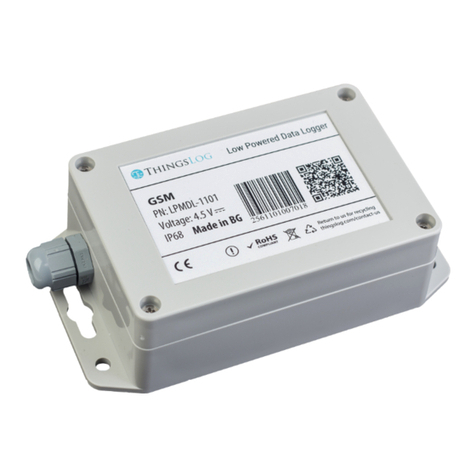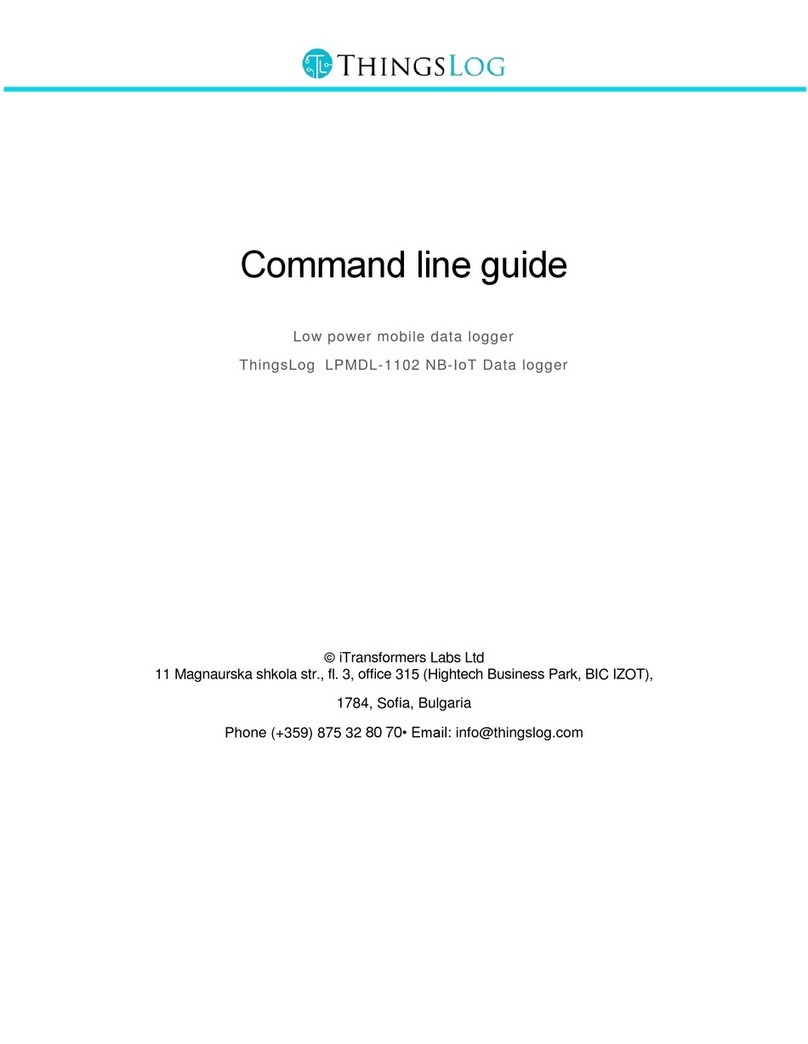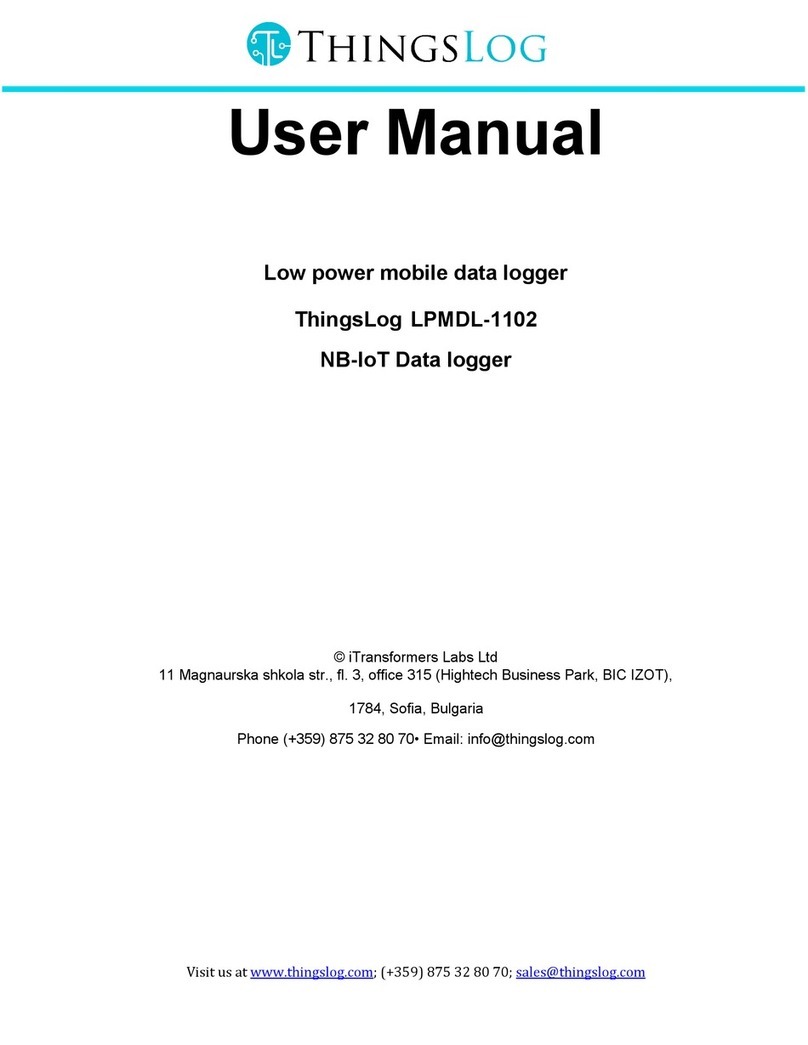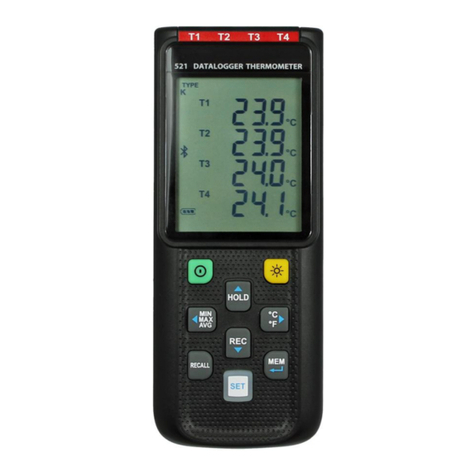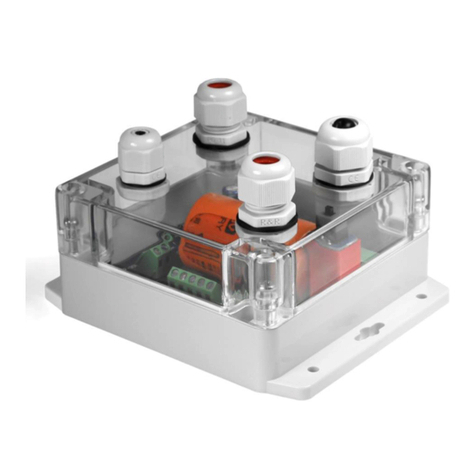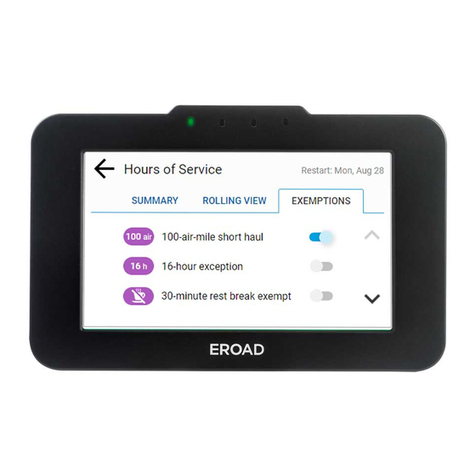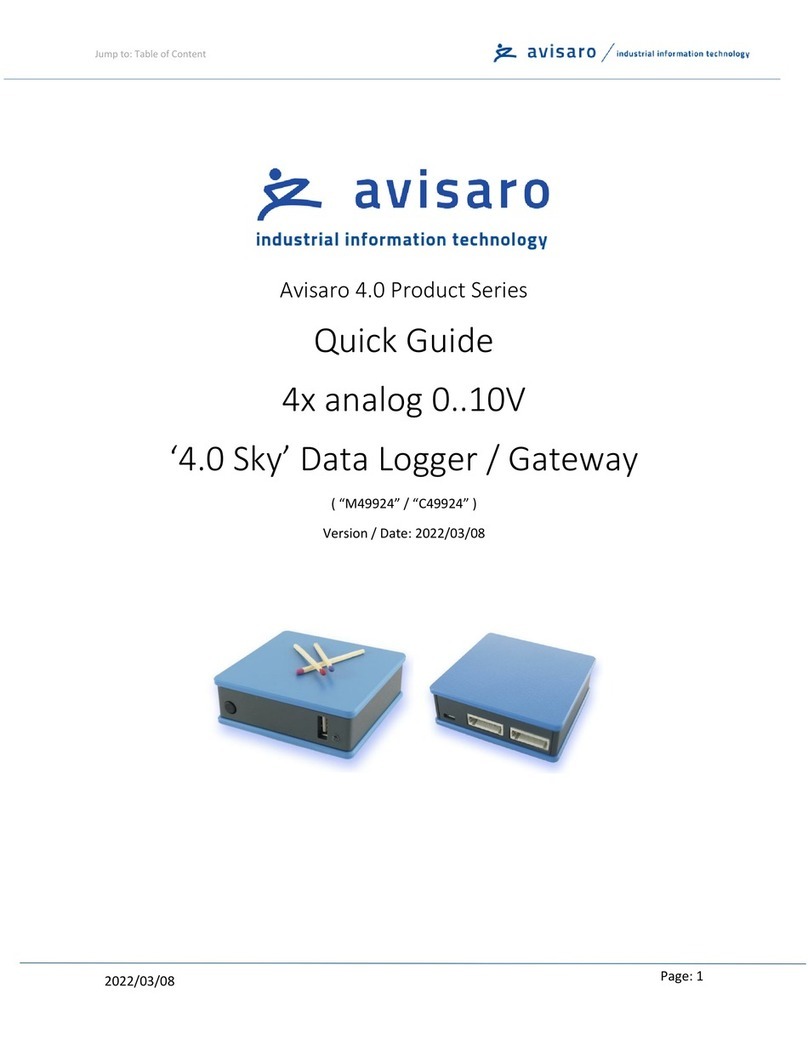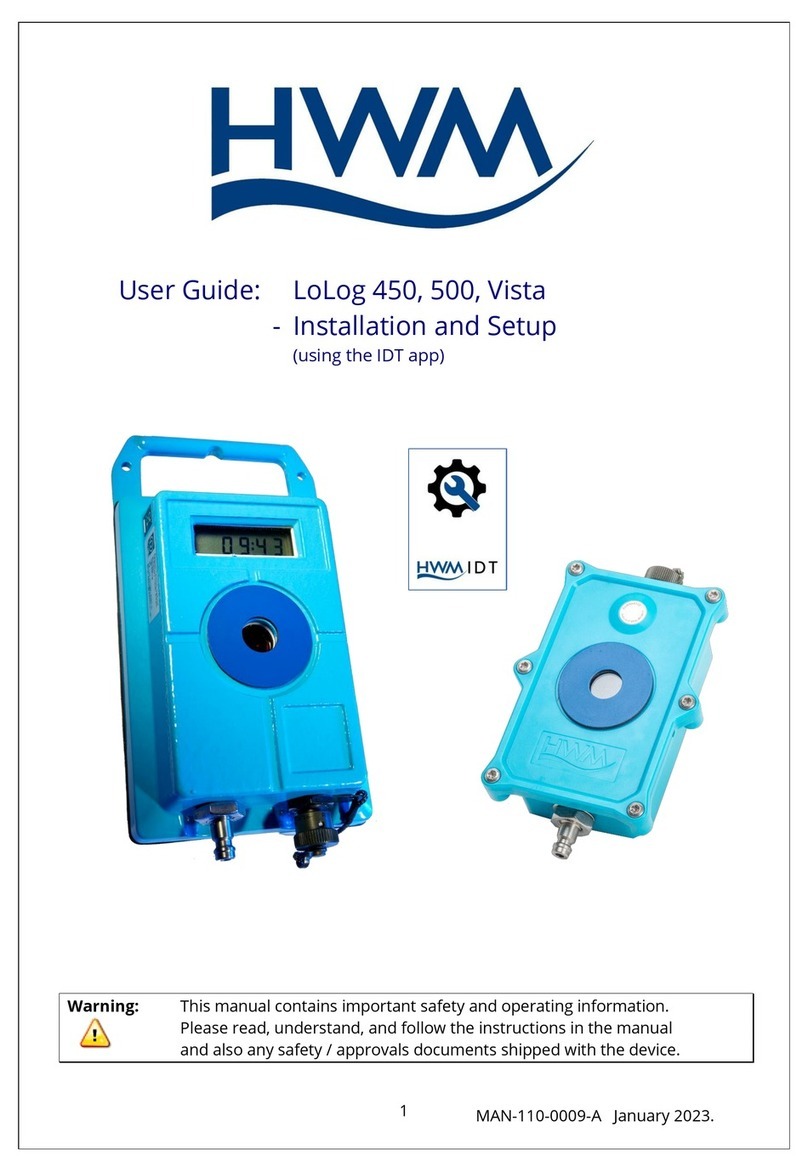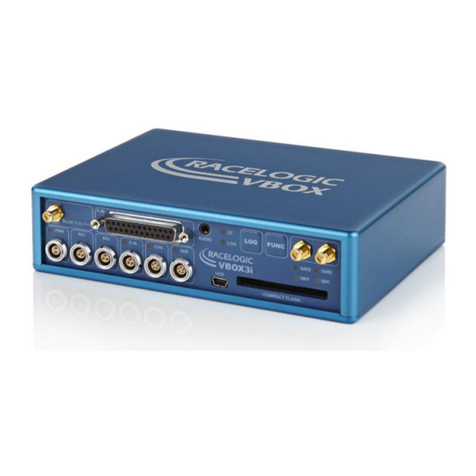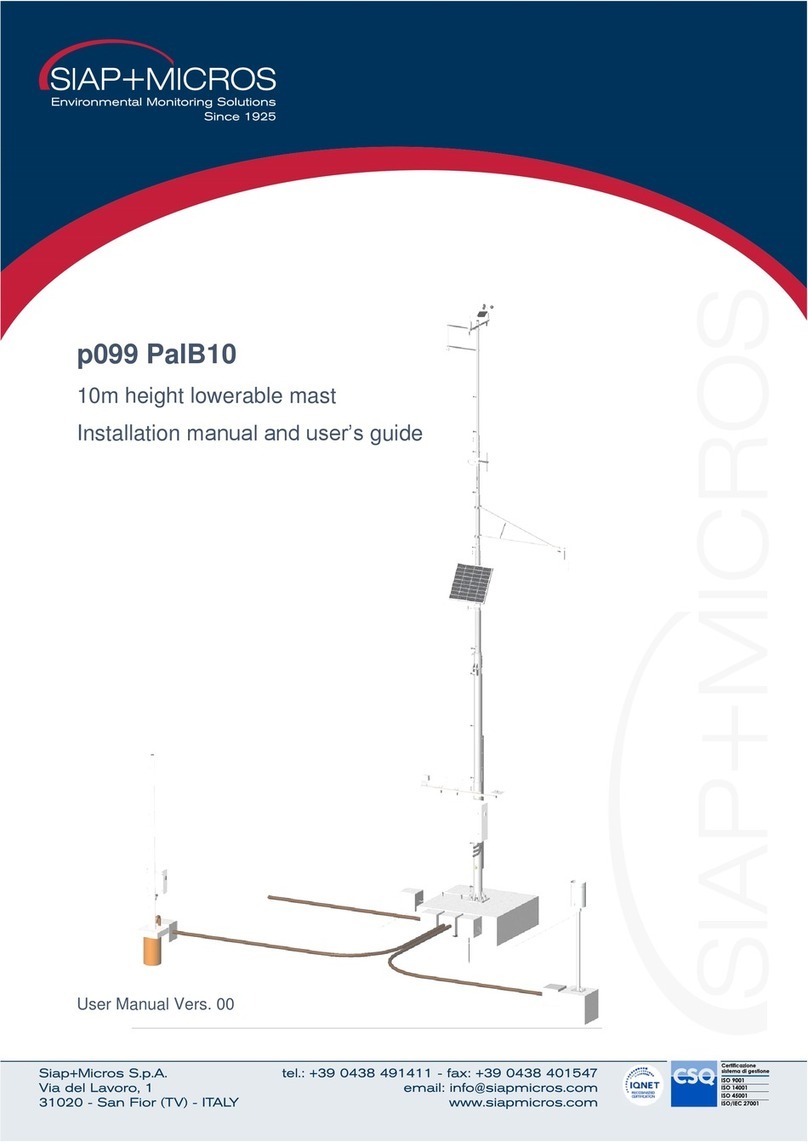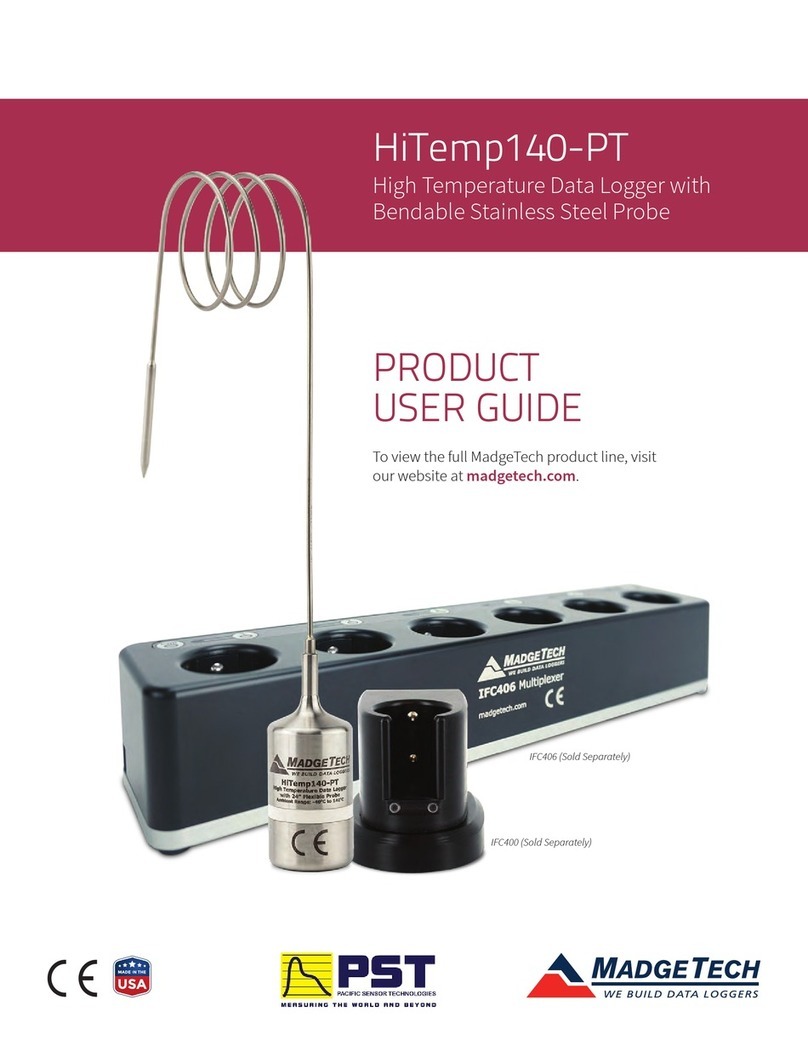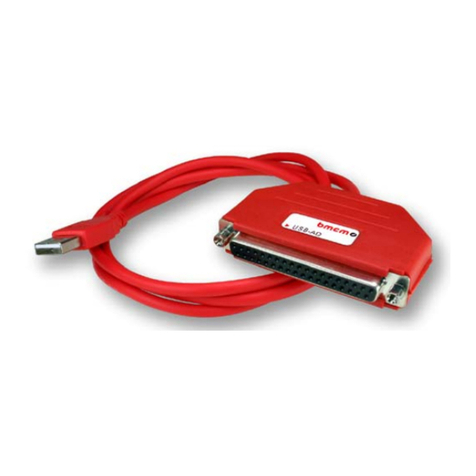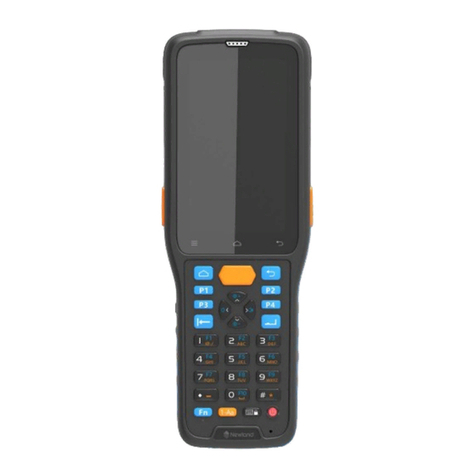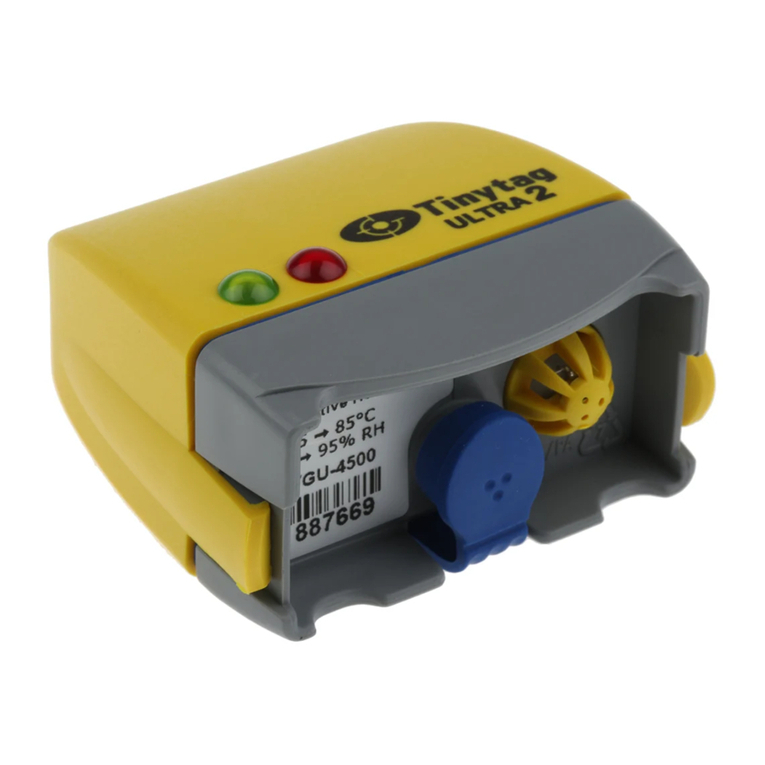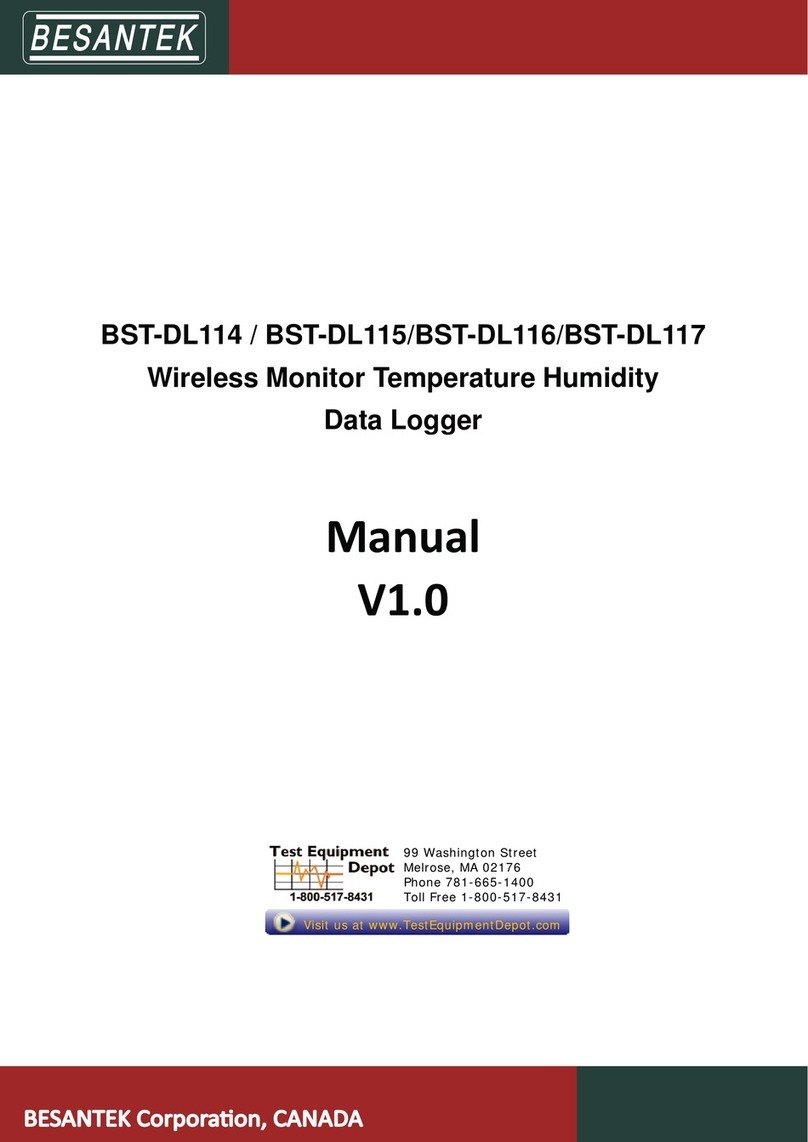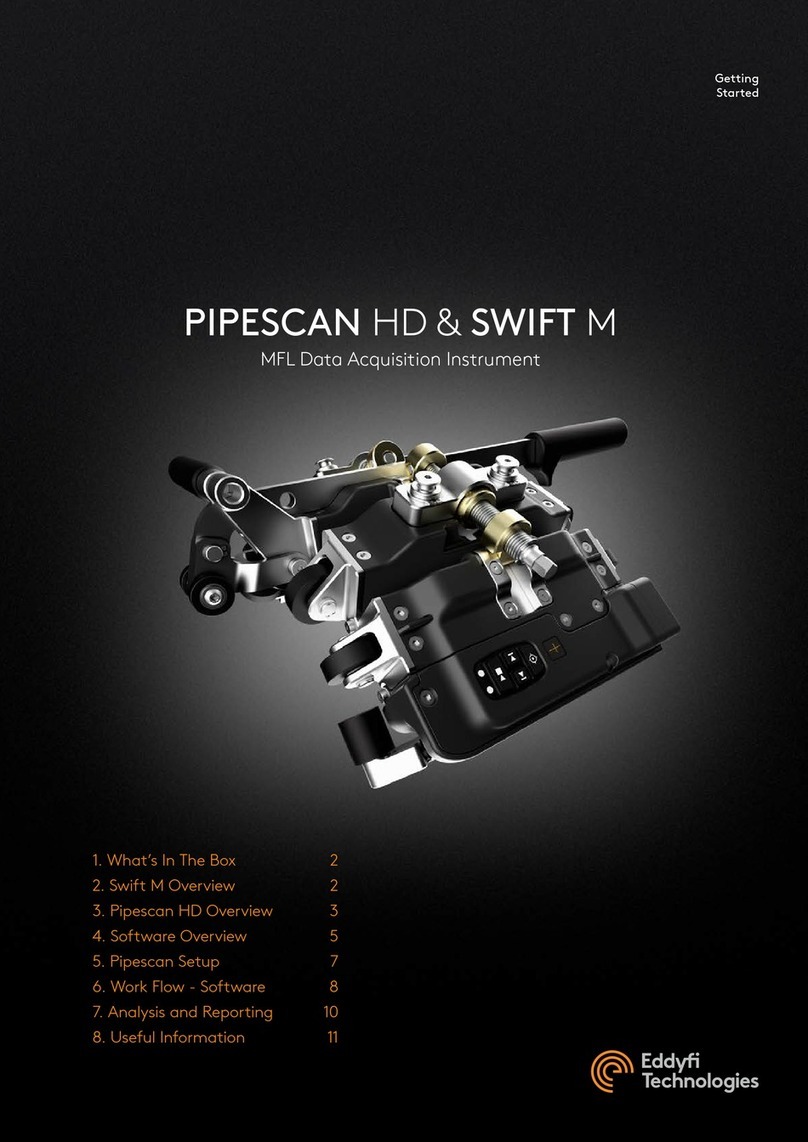ThingsLog LPMDL-110X Installation instructions

Table of Contents
Access to CLI console port......................................................................................................... 4
Base service mode .................................................................................................................... 4
Enter in Base service mode.................................................................................................... 4
Store configuration ................................................................................................................. 5
Load configuration.................................................................................................................. 5
Get device number................................................................................................................. 5
Get firmware version .............................................................................................................. 5
Get date ................................................................................................................................. 6
Set date.................................................................................................................................. 6
Get current initial config.......................................................................................................... 6
Description of configuration parameters.............................................................................. 6
Set initial config...................................................................................................................... 8
Setting up network identifiers..................................................................................................... 9
Setting and troubleshooting 2G/GPRS service mode options................................................. 9
Set collecting server address and port................................................................................ 9
Get collecting server address and port...............................................................................10
Set APN ................................................................................................................................10
Set 2G network attachment timeout.......................................................................................10
Get 2G network attachment timeout...................................................................................11
Setting up LoRa/LoRaWAN service mode options.................................................................11
Set the logger to use ABP or OTAA...................................................................................11
Get the logger to use ABP or OTAA...................................................................................11
Set the logger to send only the last full counter..................................................................11
Get the logger configuration to send only the last full counter................................................12
Set configuration application..................................................................................................12
Get collecting config application ............................................................................................12
Set Collecting application...................................................................................................13
Get collecting app collect...................................................................................................13
Setting up NB-IoT service mode options................................................................................14
Set collecting server address and port...............................................................................14
Get collecting server address and port...............................................................................14
Set APN ................................................................................................................................14

Get APN ............................................................................................................................15
Set NB-IoT network bands.................................................................................................15
Get NB-IoT network bands.................................................................................................15
Set NB-IoT network attachment timeout.............................................................................16
Get NB-IoT network attachment timeout ............................................................................16
Set MQTT parameters .......................................................................................................16
GET MQTT parameters .....................................................................................................17
Setup analog sensor settling time..........................................................................................17
Example output.........................................................................................................................18
Successful configuration and data transmission....................................................................20

Access to CLI console port
To access the command line interface you have to connect with an USBtoTTL cable to the
logger console (UART) port.
To access the console port you have to connect to the 3 pins to the right of the input ports (in
blue).
Figure 1 UART & service mode pins in LPMDL-110X
To put the device into service mode you need to press the button (red circle).
Console pins are left to right TXD RXD GND. If you are using ThingsLog console cable
•Black is GND
•Green is RXD
•White is TXD
Note: RX on the cable must be connected to TX on the board and RX on the cable must be
connected with TX on the board.
Base service mode
There are different commands that can be used to configure the GPRS device when it is in
service mode. In order to do this configuration it is necessary to put device in service mode
using the service button.
Enter in Base service mode
1. Connect to the debug UART port using baud rate 57600
2. Press the service button
3. Verify that the following message appear in UART console: "service # ". This indicates
that the device is in the base service mode
Example
service #

Store configuration
1. Verify you are in base service mode - the prompt is "service # "
2. Execute "store" command to save the configurations
3. Verify "service # " prompt appear
Example:
service # store
service #
Load configuration
1. Verify you are in base service mode - the prompt is "service # "
2. Execute load command to load the configurations
3. Verify "service # " prompt appear
Example:
service # load
service #
Get device number
1. Verify you are in base service mode - the prompt is "service # "
2. Execute number command to get the device number
3. Verify "number=00000001" hex device number appear
Example:
service # number
number=00000001
service #
Get firmware version
1. Verify you are in base service mode - the prompt is "service # "
2. Execute version command to get the firmware version
3. Verify "version=<some_version>" appear
Example:
service # version
version=0x0604bbc1
service #

Get date
1. Verify you are in base service mode - the prompt is "service # "
2. Execute date command to get the current date
3. Verify "date=<some_date>" appear
Example:
service # date
date=2017-04-01 12:40:00
service #
Set date
1. Verify you are in base service mode - the prompt is "service # "
2. Execute set_d command to set the device number
3. Verify "date=" prompt appear
4. Enter the new date in format YYYY-MM-dd HH:mm:ss
5. Verify "done" appear
Example:
service # set_d
Date=2017-04-01 12:40:00
Done
service #
Get current initial config
1. Verify you are in base service mode - the prompt is "service # "
2. Get current config by executing configure.
Example:
*** Config ***
2018-09-03 12:03:04
-----------
digits1=8
digits2=8
count_init1=1
count_init2=1
record_period=0
every=1
counts_threshold=300
sensors=01: CNT1
-----------
Description of configuration parameters
Name
Default
Value
Possible values
Description
digits1
8
•Min value: 1
•Max value: 9
Total number of
countable digits on the

display of the meter for
the first pulse input
digits2
8
•Min value: 1
•Max value: 9
Total number of
countable digits on the
display of the meter for
the second pulse input
count_init1
1
Max value depends on the digits1
value
The value of the meter
display of the first pulse
input
count_init2
1
Max value depends on the digits1
value
The value of the meter
display of the second
pulse input
record_period
0
•0 –MINUTES
•1 –HOURS
The value of the record
period 0 mean minutes
every
1
•Min value: 1
•Max value: 127
The value in record
period (1 - every 1 minute
counts_threshold
300
•Min value: 1
•Max value: 256
How many counters to
keep in memory
sensors
01
Mask of 12 bits
0000000000000000
•0 bit –Pulse sensor 1
•1 bit –Pulse sensor 2
•2 bit –analog sensor 1
•3 bit –analog sensor 2
•4 bit –On/Off sensor 1
•5 bit –On/Off sensor 2
•6 bit on/off output 1
•7 bit on/off output 2
•8 bit analog 3
•9 bit analog 4
•10 bit SEN5 –i2c sensor 1
•11 bit SEN6 –i2c sensor 2
•12 bit SEN7 –i2c sensor 3
•13 bit SEN8 –i2c sensor 4
•14 bit –future use
•16 bit –future use
For example if you want to enable
first pulse input, first analog and i2c
sensor 1 and 2 that would resolve in:
0000 1100 0000 0101
Counting right to left (big endian
stype):
0101 –first pulse and first analog
0000 –no on/offs are enabled
1100 –first 2 i2c are enabled
0000 -nothing else is enabled
Which input is active, 01
means the first pulse
input

So you have to set in set sensors:
0xC05
Hexadecimal number equal to the
binary above!!!
Set initial config
1. Verify you are in base service mode - the prompt is "service # "
2. Execute set_conf and enter the configuration menu
service # set_conf
config # help
commands:
help
set_count_init1
set_count_init2
set_digits1
set_digits2
set_rec_period
set_every
set_counts_threshold
set_sensors
save
exit
3. Set inputs reading frequency. Execute set_every
config # set_every
set_every= 3
4. Enable sensor input port
config # set_sensors
sensors= 1
5. Set counts threshold (the number of counters to be gathered prior transmission attempt).
Execute set_counts_threshold If the transmission is successful all counters will be
deleted from memory. If transmission fails counters will be kept in memory and will be
re-transmitted on next attempt. If memory got full the oldest counters will be deleted first.
config # set_counts_threshold
counts_threshold= 100
6. Set counter value. Has to be set all meaningful digits up to the magnet pointer. Execute
set_count_init1 for the first input and set_count_init2 for the second.
config # set_count_init1

count_init1= 123
config # set_count_init2
count_init2= 234
7. Save and apply the configuration.
Execute save
config # save
Save config
Applying config
Config Counters
rec_conf, size=102, rec_size=2, buff_size=206
Alarm enabled
service #
Setting up network identifiers
The logger could have different modem options: 2G, LoRa or NB-IoT.
Setting and troubleshooting 2G/GPRS service mode options
Set collecting server address and port
GSM data loggers are using by default TCP communication on port 4444.
1. Verify you are in gprs_service mode - the prompt is "gprs_service # "
2. Execute command set_addr_port
3. Verify "address=" prompt appear
4. Enter the new server address and press enter
5. Verify "port=" prompt appear
6. Enter the new server port and press enter
7. Execute resolveIp to set DNS name resolution 8 Verify that resolveIp= appears. Set it
1 to resolve address by DNS or 0 to disable resolving (address should be an IP
address).
8. Verify "done" appear
Example:
service # extension
gprs_service # set_addr_port
address=10.10.10.10
port=4444
resolve_ip=1
done
gprs_service #

Get collecting server address and port
1. Verify you are in gprs_service mode - the prompt is "gprs_service # "
2. Execute command get_addr_port
3. Verify "address=<some_ip>" appear
4. Verify "port=<some_port>" appear
Example:
service # extension
gprs_service # get_addr_port
address=10.10.10.10
port=4444
done
gprs_service #
Set APN
1. Execute command set_apn
2. Verify "apn=" prompt appears
3. Enter the new APN and press enter
4. Verify "done" appear
Example:
service # extension
gprs_service # set_apn
apn=some.operator.apn
done
gprs_service #
•Get APN
1. Execute command get_apn
2. Verify "apn=some.operator.apn" appear
Example:
service # extension
gprs_service # get_apn
apn=some.operator.apn
done
gprs_service #
Set 2G network attachment timeout
Network attachment delay is the time for which the logger will wait to be recognized and paged
by the mobile network.
1. Navigate to extension mode

2. Execute command set_net_att_delay
3. Verify "net_att_delay=some.delay " appears.
4. Enter the delay value in milliseconds (default is 35000 ms) e.g 35 seconds.
5. Don’t forget to store the configuration
Example:
service # extension
gprs_service # set_net_att_delay
net_att_delay=some.delay
done
gprs_service #
Get 2G network attachment timeout
1. Navigate to extension mode
2. Execute command get_net_att_delay
3. Verify "net_att_delay=some.delay in ms" appears
Example:
service # extension
nbmodem_service # get_net_att_delay
net_att_delay=35000
done
Setting up LoRa/LoRaWAN service mode options
Set the logger to use ABP or OTAA
5. Verify you are in lora_service mode - the prompt is "lora_service # "
6. Execute command set_use_abp
7. Enter 1 or 0, 1 –is ABP (app collect) and 0 is OTAA (app config)
8. Exit
9. Store the config
Get the logger to use ABP or OTAA
1. Verify you are in lora_service mode - the prompt is "lora_service # "
2. Execute command get_use_abp
3. 0, 1 –If setting is ABP and 0 is OTAA
Set the logger to send only the last full counter
10. Verify you are in lora_service mode - the prompt is "lora_service # "
11. Execute command set_send_last_cnt
12. Enter 1 or 0, 1 –will send only the last one, 0 will send also delta 16 bit counters)
13. Exit
14. Store the config

Get the logger configuration to send only the last full counter
4. Verify you are in lora_service mode - the prompt is "lora_service # "
5. Execute command set_send_last_cnt
6. 0, 1 –If setting is 0 will send also differential counters, if 1 will send only the last 32 bit
counter
Set configuration application
9. Verify you are in lora_service mode - the prompt is "lora_service # "
10. Execute command set_app_config
11. Verify " appkey=" prompt appear
12. Enter the new app key
13. Verify "appeui=" prompt appear
14. Enter the new appeui and press enter
15. Verify “deveui=” prompt appear
16. Enter the new deveui key
17. Verify "done" appear
Example:
lora_service # extension
set_app_config
lora_service # set_app_config
appkey=AAAAAAAAAAAAAAAAAA
appeui=BBBBBBBBBBBBBB
deveui=XXXXXXXXXXXXX
Get collecting config application
7. Verify you are in lora_service mode - the prompt is "lora_service # "
8. Execute command get_app_config
9. Verify "appkey = AAAAAAAAAAAAAAAAAA" appears
10. Verify "appeui = BBBBBBBBBBBBBB" appears
11. Verify "deveui = XXXXXXXXXXXXX" appears
12. Verify that done appears in the end
Example:
lora_service # get_app_config
appkey= AAAAAAAAAAAAAAAAAA

appeui= BBBBBBBBBBBBBB
deveui= XXXXXXXXXXXXX
done
Set Collecting application
5. Execute command set_app_collect
6. Verify " appskey=" prompt appears
7. Enter the new APPKEY and press enter
8. Verify “nwkskey=” prompt appears
9. Enter the new NWKKEY and press enter
10. Verify that the “devaddr=” prompt appears
11. Enter the devaddr and press enter
12. Verify "done" appear
Example:
lora_service # set_app_collect
appskey=AAAAAAAAAAAAAAAAAAAAAAAAAAAAAAAA
nwkskey=BBBBBBBBBBBBBBBBBBBBBBBBBBBBBBBB
devaddr=12345468
done
Get collecting app collect
3. Execute command get_app_collect
4. Verify "appkey= AAAAAAAAAAAAAAAAAAAAAAAAAAAAAAAA" appear
5. Verify “nwkskey= BBBBBBBBBBBBBBBBBBBBBBBBBBBBBBBB” appear
6. Verify “devaddr=12345468” appear
7. Verify “done” appear
Example:
lora_service # get_app_collect[\n]
appskey= AAAAAAAAAAAAAAAAAAAAAAAAAAAAAAAA
nwkskey= BBBBBBBBBBBBBBBBBBBBBBBBBBBBBBBB
devaddr=12345468
done

Setting up NB-IoT service mode options
Set collecting server address and port
1. Verify you are in gprs_service mode - the prompt is "gpr_service # "
2. Execute command set_addr_port
3. Verify "address=" prompt appear
4. Enter the new server address and press enter
5. Verify "port=" prompt appear
6. Enter the new server port and press enter
7. Execute resolveIp to set DNS name resolution 8 Verify that resolveIp= appears. Set it
1 to resolve address by DNS or 0 to disable resolving (address should be an IP
address).
8. Verify "done" appear
Example:
service # extension
gprs_service # set_addr_port
address=10.10.10.10
port=4445
resolve_ip=1
done
gprs_service #
Get collecting server address and port
1. Verify you are in gprs_service mode - the prompt is "gpr_service # "
2. Execute command get_addr_port
3. Verify "address=<some_ip>" appear
4. Verify "port=<some_port>" appear
Example:
service # extension
gprs_service # get_addr_port
address=10.10.10.10
port=4445
done
gprs_service #
Set APN
1. Execute command set_apn
2. Verify "apn=" prompt appears
3. Enter the new APN and press enter
4. Verify "done" appear
Example:

service # extension
gprs_service # set_apn
apn=some.operator.apn
done
gprs_service #
Get APN
1. Execute command get_apn
2. Verify "apn=some.operator.apn" appear
Example:
service # extension
gprs_service # get_apn
apn=some.operator.apn
done
gprs_service #
Set NB-IoT network bands
The modem supports the following network bands
B1 @H-FDD: 2100MHz
B3 @H-FDD: 1800MHz
B8 @H-FDD: 900MHz
B5 @H-FDD: 850MHz
B20 @H-FDD: 800MHz
B28 @H-FDD: 700MHz
You can configure the network bands with the following CLI command. Note that you may configure
more than one network band.
Example:
service # modem
nbmodem_service # set_bands
bands=8,28
nbmodem_service # exit
Get NB-IoT network bands
1. Navigate to modem
2. Execute command get_bands
3. Verify "bands=some.band" appears
Example:

nbmodem_service # get_bands
bands=28
done
nbmodem_service # exit
Set NB-IoT network attachment timeout
Network attachment delay is the time for which the logger will wait to be recognized and paged
by the mobile network.
6. Navigate to extension mode
7. Execute command set_net_att_delay
8. Verify "net_att_delay=some.delay " appears.
9. Enter the delay value in milliseconds (default is 15000 ms) e.g 15 seconds.
Example:
service # extension
gprs_service # set_net_att_delay
net_att_delay=some.delay
done
gprs_service #
Get NB-IoT network attachment timeout
10. Navigate to extension mode
11. Execute command get_net_att_delay
12. Verify "net_att_delay=some.delay in ms" appears
Example:
service # extension
nbmodem_service # get_net_att_delay
net_att_delay=15000
done
Set MQTT parameters
Note: MQTT is available only in loggers with MQTT firmware!!!
To configure the mqtt username
1. Navigate to extension mode
2. Execute command set_mqtt
3. Verify that the username/password and root topic prompts appear.
4. All strings parameters be < 10 symbols in length
service # extension

nbmodem_service #set_mqtt
username=mqtt_user
password=mqtt_pass
root_topic=mqtt_topic
GET MQTT parameters
1. Navigate to extension mode
2. Execute command get_mqtt
service # extension
nbmodem_service #get_mqtt
username=mqtt_user
password=mqtt_pass
root_topic=mqtt_topic
Setup analog sensor settling time
Analog sensors values are obtained by 16 bit Analog to digital convertor (ADC).ADC
reading time is a parameter that is valid only if you have a logger with analog ports. It should be
equal or bigger than the analog sensor setting time. Setting time is the time required by the
sensor placed in its particular environment to produce a correct measurement and output it on
its analog port. The adc reading time is in ms. Sensors suitable for low power measurements
have short adc read times (10-50ms). Setting ADC reading time to 0 means that the logger will
not switch off the power supply to the sensor and will not measure its values in low power mode.
This is the ideal mode for sensors on power.
1. Execute command set_adc_read_time
2. Verify "adc_read_time=" appears

Note: The default ADC read time for LPMDL-110X is 50 ms. If you want to disable the logger to
switch on/off the power supply of the logger you have to set the ADC read time to 0.
Example output
Successful data transmission –NB-IoT
>>> Modem ON[\r][\n]
>>> wait modem to start up[\r][\n]
>>> To Modem: AT[\r][\n]
>>> From Modem: [\xFFFFFFFF][\xFFFFFFFF][\r][\n]
>>> Boot: Unsigned[\r][\n]
>>> Security [\r][\n]
>>> OK[\r][\n]
>>> To Modem: AT+CMEE=1[\r][\n]
>>> From Modem: [\r][\n]
>>> OK[\r][\n]
>>> To Modem: ATE0[\r][\n]
>>> From Modem: [\r][\n]
>>> OK[\r][\n]
>>> To Modem:AT+NCONFIG=AUTOCONNECT,FALSE[\r][\n]
>>> From Modem: [\r][\n]
>>> OK[\r][\n]
>>> To Modem:AT+CPSMS=0[\r][\n]
>>> From Modem: [\r][\n]
>>> OK[\r][\n]
>>> To Modem: AT+CFUN=0[\r][\n]
>>> From Modem: [\r][\n]
>>> OK[\r][\n]
>>> To Modem: AT+CFUN?[\r][\n]
>>> Sys: CFUN->[\r][\n]
>>> +CFUN:0[\r][\n]
>>> [\r][\n]
>>> OK[\r][\n]
>>> [\r][\n]
>>> To Modem: AT+QCHIPINFO=VBAT[\r][\n]
>>> Sys: Voltage->[\r][\n]
>>> +QCHIPINFO:VBAT,2556[\r][\n]
>>> [\r][\n]
>>> To Modem: AT+CFUN=1[\r][\n]
>>> From Modem: [\r][\n]
>>> OK[\r][\n]
>>> To Modem: AT+CFUN?[\r][\n]
>>> Exp:*+CFUN:*[\r][\n]
>>> [\r][\n]
>>> OK[\r][\n]
>>> *[\r][\n]
>>> Buf:*[\r][\n]

>>> +CME ERROR: 51[\r][\n]
>>> [\r]*[\r][\n]
>>> To Modem: AT+CFUN?[\r][\n]
>>> Sys: CFUN->[\r][\n]
>>> +CFUN:1[\r][\n]
>>> [\r][\n]
>>> OK[\r][\n]
>>> [\r][\n]
>>> To Modem: AT+CGDCONT=1,"IP","iot-test"[\r][\n]
>>> From Modem: [\r][\n]
>>> OK[\r][\n]
>>> To Modem: AT+QIDNSCFG=8.8.8.8,4.2.2.2[\r][\n]
>>> From Modem: [\r][\n]
>>> OK[\r][\n]
>>> mdm: AT+COPS=0[\r][\n]
>>> From Modem: [\r][\n]
>>> OK[\r][\n]
>>> AT+CEREG=1[\r][\n]
>>> From Modem: [\r][\n]
>>> OK[\r][\n]
>>> AT+CEREG?[\r][\n]
>>> BUFF [\r][\n]
>>> +CEREG:1,2[\r][\n]
>>> [\r][\n]
>>> OK[\r][\n]
>>> [\r][\n]
>>> reg den check: 1[\r][\n]
>>> Reg trying[\r][\n]
>>> AT+CEREG?[\r][\n]
>>> BUFF [\r][\n]
>>> +CEREG:1[\r][\n]
>>> [\r][\n]
>>> +CEREG:1,1[\r][\n]
>>> [\r][\n]
>>> O[\r][\n]
>>> reg den check: 0[\r][\n]
>>> Reg ok[\r][\n]
>>> To Modem: AT+CGATT?[\r][\n]
>>> From Modem: [\r][\n]
>>> +CGATT:1[\r][\n]
>>> [\r][\n]
>>> OK[\r][\n]
>>> To Modem: AT+CSQ[\r][\n]
>>> Sys: Signal->[\r][\n]
>>> +CSQ:1,99[\r][\n]
>>> [\r][\n]
>>> OK[\r][\n]
>>> [\r][\n]
>>> rssi=1,ber=99[\r][\n]
>>> To Modem: AT+QDNS=0,iot.thingslog.com[\r][\n]
>>> ip_addr: 78.128.42.106[\r][\n]
>>> To Modem: AT+NSOCR=DGRAM,17,4587,1[\r][\n]
>>> Socket: 1[\r][\n]
>>> Sending cnt.len=30[\r][\n]
>>> To Modem: AT+NSOST=1,78.128.42.106,4445,56,FFFFFF2F040031[\r][\n]
>>> 1A06160108173500[\r][\n]

>>> 2A020163[\r][\n]
>>> 2B0209FC[\r][\n]
>>> 3F001EFrom Modem: [\r][\n]
>>> 1,56[\r][\n]
>>> [\r][\n]
>>> OK[\r][\n]
>>> From Modem: [\r][\n]
>>> +NSONMI:1,12[\r][\n]
>>> [\r][\n]
>>> To Modem: AT+NSORF=1,12[\r][\n]
>>> From Modem: [\r][\n]
>>> 1,78.128.42.106,4445,12,0000091A0716010817351C06,0[\r][\n]
>>> [\r][\n]
>>> OK[\r][\n]
>>> [\r][\n]
>>> Parsing data, rx_size: 12[\r][\n]
>>> Data: 00 00 09 1A 07 16 01 08 17 35 1C 06 [\r][\n]
>>> Abs time : 2022-01-08 23:53:28[\r][\n]
>>> Curr time : 2022-01-08 23:53:28[\r][\n]
>>> Delta time: 0[\r][\n]
>>> To Modem: AT+NSOCL=1[\r][\n]
>>> From Modem: [\r][\n]
>>> OK[\r][\n]
>>> Modem OFF[\r][\n]
>>> Post counters success[\r][\n]
>>> ST=2022-01-08 23:53:28[\r][\n]
Successful configuration and data transmission –LoRa/LoRaWAN
In this scenario in the backend has been pressed “Start setup” the timer start ticking and the
logger obtained its configuration successfully.
In Bold are key messages with #we put some comments.
>> WKUP 2020-04-19 06:17:00[\r][\n]
>>> [2]=0 0 0 0 [\r][\n]
>>> FIFO: f=0, r=7, r_size=8, size=288[\r][\n]
>>> FIFO: num=3, size=2, max_size=36[\r][\n]
>>> Lora send counters[\r][\n]
>>> Mdm start[\r][\n]
>>> From Modem: RN2903 1.0.5 Nov 06 2018 10:45:27[\r][\n]
>>> sys get vdd[\r][\n]
>>> Bat: 2778[\r][\r][\n]
>>> mac set appkey *[\r][\n]
>>> From Modem: ok[\r][\n]
>>> mac set appeui *[\r][\n]
>>> From Modem: ok[\r][\n]
>>> mac set deveui *[\r][\n]
>>> From Modem: ok[\r][\n]
>>> mac set linkchk 44[\r][\n]
>>> From Modem: ok[\r][\n]
>>> mac save[\r][\n]
>>> From Modem: ok[\r][\n]
>>> OTAA init[\r][\n]
>>> mac get status[\r][\n]
>>> buff=00000440[\r][\n]
Table of contents
Other ThingsLog Data Logger manuals

